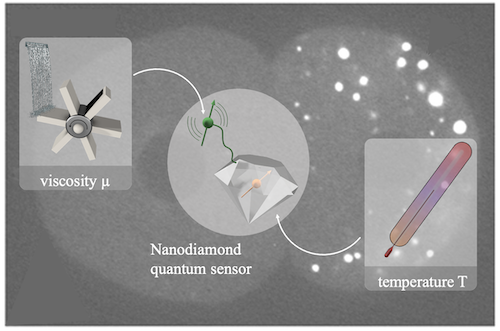2021 CPB Pump Priming Grants
The Cambridge Centre for Physical Biology - Pump Priming Grants is an annual scheme aimed at generating new collaborations between early career research teams with complementary expertise, this way promoting multidisciplinary research in the field of physical biology in the University of Cambridge.
The CPB is pleased to announce that the winners of this year’s Pump Priming Grants are: Helena Knowles & David Jordan, and Mekayla Storer & Kevin Chalut. Congratulations!
You can read about their projects below.
Helena Knowles (Physics) and David Jordan (Genetics & Gurdon)
Title: Nanoscale temperature sensing in living organisms
Chemical systems in isolation will approach thermodynamic equilibrium, a unique steady state with no net flows of matter or energy. In biology, thermodynamic equilibrium is synonymous with death and systems must avoid it by continuously spending energy; staying out of equilibrium is a principle of life. Temperature, energy, and entropy are defining properties of equilibrium in macroscopic systems. However, at the nanoscale these concepts must be considered differently than for ensembles in large systems. We aim to develop a quantum sensing technology, NV-center nano diamonds, with which to probe the thermodynamics of nano-scale biochemical reactions. Existing probes suffer from several disadvantages including photobleaching and unstable fluorescence and often degrade into products that interfere with biochemical pathways. Diamond nano-sensors do not suffer these drawbacks and exploit the spins of atomic defects to report on their local environment. Through their optical signature, these probes can sense both temperature and their electromagnetic environment with unprecedented resolution. Of particular interest are the highly compartmentalized reactions which do not require membrane-bound organelles, e.g. the RNA/protein granules in C. elegans, and especially those that occur within phase-separated liquid like condensates. While the roles of these condensates are unknown, they may organize reactions to form alternative complexes from the same sets of components. This could be crucial for solving problems arising from cellular stress, or ageing e.g. Such a role is consistent with the importance of granules in a variety of responses to environmental cues, including stress response, transcriptional regulation, and activity dependent local translation at neuronal synapses.
Keywords: Nano-diamond quantum sensor, Nanoscale thermometry, Out-of-Equilibrium physics, Liquid-liquid phase transitions, C. elegans
Graphical abstract
Figure legend: Nanodiamond quantum probe acting as dual-modality sensor for nanoscale viscosity and temperature measurements.
Mekayla Storer (Stem Cell Institute) and Kevin Chalut (Stem Cell Institute, PDN & Physics)
Title: Investigating the mechanical cues that regulate mammalian digit tip regeneration
An unanswered question in regenerative biology is why mammals fail to regenerate their limbs while other animals such as salamanders have this capacity. Intriguingly, mice and humans can regrow the tip of their digits following amputation. This hints at the possibility that we have inherited the ability to regenerate limbs or entire fingers, yet the cells are not receiving the relevant instructions to do so. In this project we will investigate if mechanical forces play an important role in directing cells to regenerate the digit tip. We believe that mechanical cues may be critical for regeneration because these forces have been shown to transform disorganised groups of cells into complex, organised tissues during embryonic development. Here we will use different types of microscopy techniques to map out how the tissue scaffolds, which are responsible for regulating external forces, change during regeneration. Additionally we will culture regenerating digit tip cells on specialised surfaces called ‘StemBond’ hydrogels. Using these hydrogels, we are able to change the type of scaffold or how soft or hard the surface is. This will allow us to determine how these mechanical properties influence what decisions the cells make. Altogether, this study will help us understand whether changing the tissue mechanics during injury can promote regeneration, reduce scarring and may provide a means to treat injuries and degenerative diseases in humans.
Keywords: Regeneration, Mechanobiology, Cell Fate Decisions, Extracellular, Matrix Proteins, ‘StemBond' Hydrogels
Graphical abstract
Figure legend: Scanning electron microscopy image of cultured blastema cells derived from regenerating mouse digit tips.



